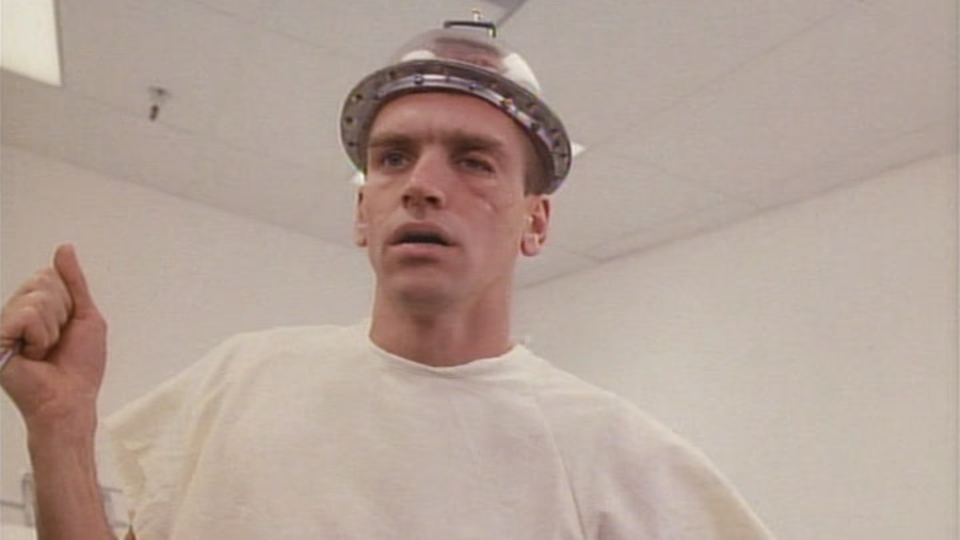Silent Night, Deadly Night 3: Better Watch Out!

The original Silent Night, Deadly Night, a low-budget exploitation horror, triggered outrage and protests. The second film veered into camp and proved notorious as well, perceived as a cash-grab recycling large amounts of the first film‘s footage.
This third entry in the Santa-slasher series loses the Santa costume but gains name recognition with director Monte Hellman and stars Bill Moseley and Robert Culp. The result? A head-scratching mess devoid of thrills, camp or otherwise.
The story, set after the events of part two, sees Ricky survive his apparent death thanks to some improbable surgery. He now lies comatose in a California hospital where smarmy doctor Newbury tries to leverage blind young Laura’s psychic ability to infiltrate Ricky’s slumbering conscious.
If this premise seems familiar, it’s because you’ve seen Friday the 13th: The New Blood.
Ricky soon wakes up and beelines it to Laura’s childhood home to kill her. It’s not clear why, as the film goes through pains to present Ricky as a Frankenstein-like sympathetic monster, whose killing rage only emerges when he sees the color red, because a red-clad Santa murdered his parents when he was an infant and he witnessed another red-clad Santa’s accidental shooting when he was a schoolboy.
We see both events via flashbacks to the first film, but we get no footage from the prior film, perhaps to avoid drawing attention to Ricky’s recasting. Eric Freeman and his animated eyebrows are out, replaced by Bill Moseley, sporting what he refers to in an interview as a “blinking brain cap”, and which he describes as a “clear plastic salad bowl with blinking lights on the back, I guess in case I backed up or something.”
Moseley’s near-silent performance continues the Frankenstein motif, with his stilted gait and dead-eyed expression. He convinces as a tortured monster, but pathos isn’t what the film needs.
It needs action. The film lumbers from one dialogue-heavy scene to another. The performers lack the charisma to elevate the material. As Laura, first timer Samantha Scully doesn’t convince as blind, rendering her entire performance artificial. Eric DaRe, son of Aldo Ray, plays her brother, and also struggles with the talky script. Their exchanges feel wooden, reminiscent of a bad audition, as though each were waiting for their cue to speak versus conversing.
Their relative inexperience becomes clear when Robert Culp arrives midway through playing a detective. The lone beacon of charisma, Culp outshines everyone, making their performances feel amateurish in comparison, and making me wish he was in a better movie.
Hellman should have known better. A good exploitation picture can overcome a novice cast by substituting action for dialogue. Show versus tell. Hellman’s film has most of Ricky’s murders happen off screen. Instead of set piece kills, he skips to gruesome shots of the mutilated victims. To fill the time, Hellman proffers scenes of characters talking, taking baths, and star gazing. In perhaps the worst example, we get a dark scene of Culp and Doctor Newbury driving up a freeway with Culp trying to sell Newbury on the merits of the car phone.
All this filler drains the film of any tension. We wait for something—anything—to happen. There’s no sense of dread to compensate, and the generic sets lack the prior films’ sense of verisimilitude. It proves a tedious watch and, for an exploitation picture, tedium is a cardinal sin.
Worst of all, when the finale arrives, it underwhelms. Consider Ricky’s first attack scene. Laura, her brother Chris, and her brother‘s girlfriend Jerri are inside a farmhouse. Jerri stands by the door. Ricky’s arms burst through the door and grab Jerri, choking her. “Oh, shit,” says Chris, as though someone just spilled wine on his new couch. Chris runs off screen. Jerri struggles. Blind Laura does nothing. There’s no score. Just dead air and a stagnant medium shot. Chris returns with a small knife, stabs Ricky through the arm, then runs off screen again. More dead-air silence as Ricky releases Jerri, who drops to the floor. Ricky retreats. A beat or two passes, then Chris returns and asks Jerri if she’s okay.
Such awkward pacing and stilted editing evoke an amateur production, and pale next to any scene in the prior films, which—for all their faults—were never boring. Hellman’s decision to jettison the Santa-slasher formula proves ill-advised. Without it, he’s left to pad the running time with meandering scenes delivered by inexperienced performers. It makes part two’s decision to recycle so much footage look brilliant in comparison.